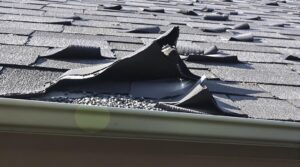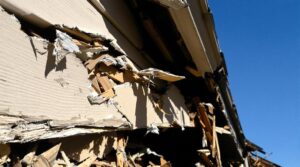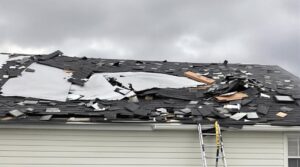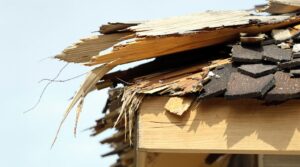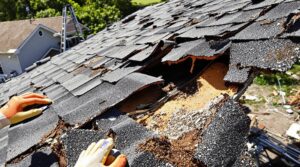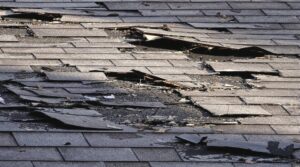Is your flat roof throwing a tantrum after that windstorm? Let's talk about what happens when Mother Nature tests your roofing system. Think of your roof's membrane like a well-secured blanket – when wind gets underneath, it can start lifting and separating those crucial layers, much like peeling back a bandage.
You'll want to watch for three telltale signs: bubbling surfaces (we call these blisters), visible tears in the material, and those pesky edges that start lifting like dog-eared pages in a book. These aren't just cosmetic issues – they're your roof's cry for help!
Wondering about costs? Minor fixes might set you back as little as $200 if you're lucky, while major overhauls could reach $15,000 if the damage is extensive. The good news? Most insurance policies have your back when it comes to wind damage.
Here's a pro tip: considering a public adjuster? They're like your personal roof advocates, diving deep into the technical details and fighting for every dollar you deserve. They'll translate that complex insurance jargon into plain English and help ensure you're not left out in the rain (literally!) when it comes to your claim settlement.
Key Takeaways
Is Your Roof Telling You It's Had Enough of Mother Nature's Tantrums?
Let's Talk Wind Damage Warning Signs
Think of your roof as a shield – when wind plays rough, it leaves behind telltale battle scars. You'll spot membrane tears dancing along the surface, edges lifting like dog-eared pages, bubbling blisters on your shingles, and sometimes even missing pieces that left the party too early. These aren't just cosmetic issues – they're your roof's cry for help!
The Money Talk: What's This Going to Cost Me?
Minor wind damage fixes might feel like a small pinch to your wallet ($200-$1,000), but when your roof needs a complete makeover, you're looking at a more substantial investment ($5,000-$15,000). Think of it as your roof's spa day – sometimes a quick facial does the trick, other times you need the full treatment package.
Insurance Coverage: Your Financial Safety Net
Good news! Your standard homeowner's insurance typically has your back when wind throws a tantrum. You'll encounter two main coverage types: Actual Cash Value (think depreciated value) or Replacement Cost Value (the whole nine yards). But here's the kicker – having a public adjuster in your corner can be a game-changer. They're like roof damage detectives, working to maximize your claim for a slice (5-15%) of the settlement pie.
Pro Tip: Become a Documentation Detective
When wind damage strikes, channel your inner photographer! Snap detailed photos, get professional inspection reports, and write descriptions like you're telling a story. The more evidence you gather, the stronger your case becomes. Think of it as building your roof's defense portfolio – the more detailed, the better your chances of a successful claim.
Common Types Of Wind Damage To Flat Roofing
Flat roofs present unique vulnerabilities to wind damage that can compromise their structural integrity and protective function. Strong winds can create powerful forces that affect multiple components of the roofing system, from the membrane to the underlying structure. Uplift Damage occurs when wind forces separate the roofing membrane from the substrate, while Fastener Displacement can lead to system instability and water infiltration. Wind speeds above 74mph can cause significant structural vulnerabilities that require immediate professional inspection.
| Type of Damage | Impact on Roof |
|---|---|
| Membrane Tears | Material separation and exposure |
| Edge Failures | Perimeter lifting and detachment |
| Material Distortion | Bubbling and surface deformation |
| Uplift Issues | Layer separation and system failure |
| Fastener Problems | Loose connections and instability |
These forms of damage require prompt attention as they can quickly escalate into more severe structural issues that compromise the building's weather protection capabilities.
Warning Signs Your Flat Roof Needs Repairs From Wind Damage
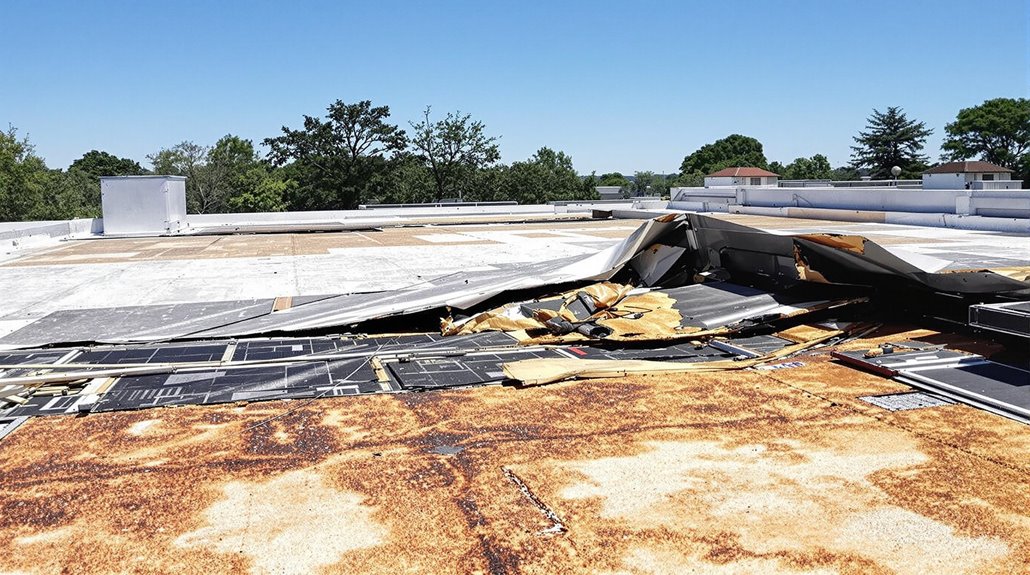
Recognizing the warning signs of wind damage on a flat roof is essential for preventing extensive structural deterioration and costly repairs. Property owners should incorporate regular flat roof maintenance inspections to identify potential issues before they escalate. Key indicators include blistering, wrinkling, and visible separation of roofing materials, particularly along edges and corners where wind uplift is most severe.
| Warning Sign | Impact on Flat Roof |
|---|---|
| Blistering/Wrinkling | Compromised surface integrity |
| Cracks/Tears | Potential water infiltration |
| Discolored Patches | Material deterioration |
| Missing Materials | Exposed underlayment |
| Uplifted Layers | Structural vulnerability |
Wind damage prevention requires immediate attention to these indicators. Internal signs such as water stains or leaks often signal that external damage has already occurred, necessitating professional assessment and prompt repairs to maintain roof integrity. Professional repairs typically cost between 750-2500 dollars for addressing wind-related damage on roofing systems.
Does Homeowners Insurance Cover Wind Damaged Flat Roof Claims?
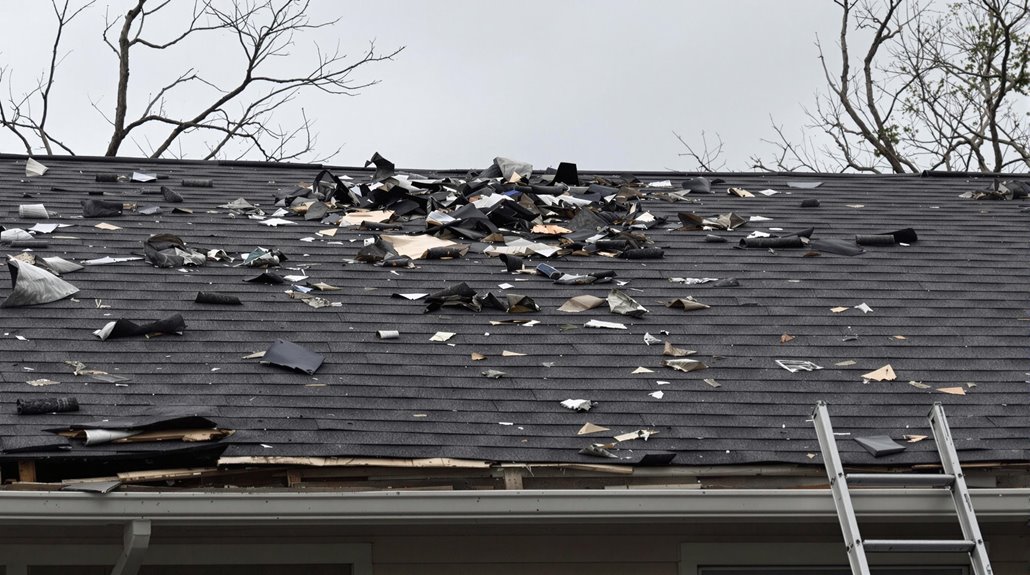
Standard homeowners insurance policies generally cover wind damage to flat roofs, though coverage specifics depend on policy type and exclusions. Insurance payouts vary considerably between Actual Cash Value (ACV) policies, which factor in depreciation, and Replacement Cost Value (RCV) policies that cover full replacement costs. Deductibles for wind damage claims tend to be higher in storm-prone regions, with some policies requiring separate windstorm coverage or excluding damage from named storms altogether. Working with public insurance adjusters can significantly increase claim settlements by 20-800% through professional documentation and strategic negotiations.
| Coverage Type | Key Features | Considerations |
|---|---|---|
| Actual Cash Value | Depreciated payout based on roof age | Lower premiums, higher out-of-pocket costs |
| Replacement Cost Value | Full replacement coverage | Higher premiums, better protection |
| Named Perils | Specific wind events covered | Limited to listed perils only |
| All-Risk Coverage | Extensive protection | Higher cost, fewer exclusions |
Insurance Deductibles, Coverage Limits, & Exclusions For Flat Roof Wind Damage Claims
When filing insurance claims for wind-damaged flat roofs, homeowners must navigate three critical aspects: deductibles, coverage limits, and exclusions. Insurance policies typically require deductible adjustments based on location and risk factors, while coverage comparisons reveal varying limits for structural repairs and replacements.
| Insurance Aspect | Key Considerations |
|---|---|
| Deductibles | Higher rates in storm-prone areas |
| Coverage Limits | Based on dwelling coverage value |
| Named Storms | Special deductibles may apply |
| Installation Issues | Not covered if improperly installed |
| Documentation | Photos and inspection reports required |
Standard policies exclude flood damage, even when wind-related, and may not cover damage from improper installation or maintenance neglect. In high-risk zones, special windstorm deductibles often apply separately from regular deductibles, affecting the final claim payout. Professional inspections and thorough documentation strengthen claims processing success. Working with public insurance adjusters can increase claim settlements by up to 574% through their expertise in policy interpretation and documentation.
Actual Cash Value Vs. Replacement Cost In Relation To Flat Roof Wind Damage
A homeowner's choice between Actual Cash Value (ACV) and Replacement Cost Value (RCV) insurance substantially impacts the financial outcome of flat roof wind damage claims. ACV policies factor in depreciation, resulting in lower payouts that may leave significant out-of-pocket expenses, while RCV policies cover the full replacement cost without depreciation.
| Feature | Actual Cash Value | Replacement Cost |
|---|---|---|
| Depreciation | Applied | Not Applied |
| Coverage Amount | Partial | Full |
| Premium Cost | Lower | Higher |
| Out-of-Pocket Risk | Higher | Lower |
Understanding these differences becomes vital when selecting coverage. RCV policies typically provide thorough protection but command higher premiums, while ACV policies offer lower premiums but potentially significant cost-sharing during claims. Homeowners should carefully evaluate their financial capacity and risk tolerance when choosing between these options for flat roof wind damage coverage. Working with public insurance adjusters can increase claim settlements by 30-50% compared to filing independently.
Named Vs. Hidden Perils
Understanding how homeowners insurance treats wind damage to flat roofs requires distinguishing between named and hidden perils. While standard policies typically include wind damage as a named peril, several hidden perils can affect coverage and claims.
| Named Perils | Hidden Perils |
|---|---|
| Wind damage to roofing | Pre-existing maintenance issues |
| Storm-related structural damage | Age-related deterioration |
| Window and siding damage | Undocumented prior damage |
| Direct impact from debris | Concurrent flood damage |
| Lightning-related damage | Poor installation methods |
Insurance providers carefully evaluate claims based on both types of perils. Named perils offer straightforward coverage, while hidden perils often lead to claim denials or reduced payouts. Flat roof owners must be particularly vigilant about documentation and maintenance, as these structures face unique challenges in proving wind damage separate from pre-existing conditions. Working with public insurance adjusters can increase claim settlements by 20-50% through their specialized knowledge in policy interpretation and professional representation during negotiations.
Repair Vs. Replacement For Flat Roof Wind Damage
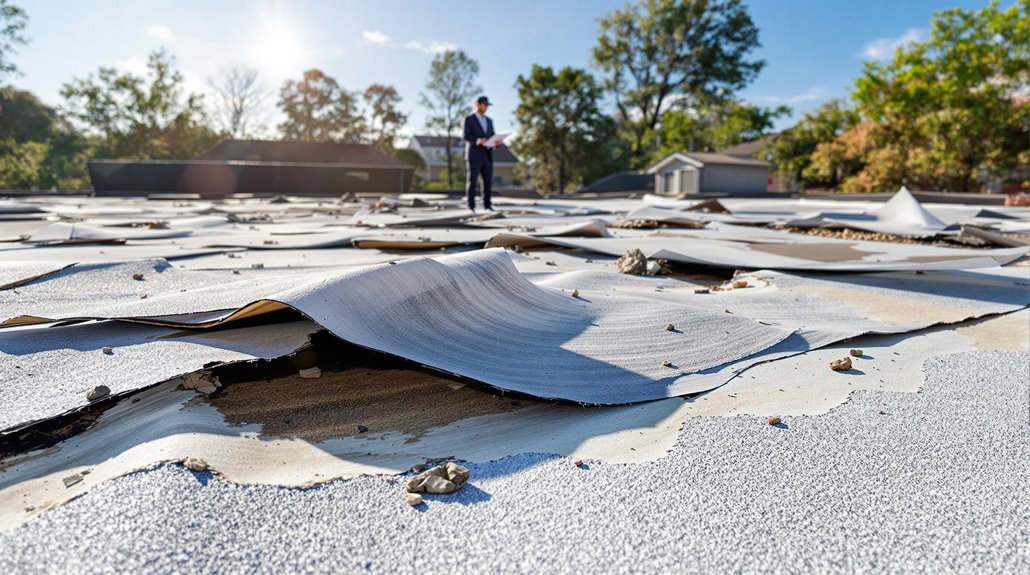
When facing wind damage to a flat roof, property owners must carefully evaluate whether repair or replacement is the most viable solution.
The decision between repair and replacement depends on factors including the extent of damage, age of the roof, and available budget. While repairs may suffice for minor or localized damage, complete replacement becomes necessary when structural integrity is compromised or the roof is nearing the end of its service life.
- Repairs are cost-effective for isolated damage with costs ranging from $200-$1,000, while full replacements typically range from $5,000-$15,000.
- Minor issues like loosened membranes or slight misalignment can be effectively addressed through targeted repairs.
Complete replacement offers enhanced energy efficiency, improved property value, and elimination of recurring maintenance costs.
Hiring a public adjuster for insurance claims can increase settlement amounts by up to 574% compared to self-filed claims.
When To Choose Roof Repair For A Wind Damaged Flat Roof
Making informed decisions about repairing versus replacing a wind-damaged flat roof requires careful evaluation of multiple factors, including the extent of damage, roof age, and financial considerations. A thorough cost analysis reveals that repair options are often viable when damage is localized and the roof structure remains fundamentally sound. Public adjuster representation can increase claim settlements by up to 50% when pursuing insurance coverage for repairs. In addition to costs, homeowners should also look for wind damage signs on roofs, such as missing shingles, granule loss, or visible leaks, which can indicate whether a repair or replacement is truly necessary. If such signs are prevalent and the roof is nearing the end of its lifespan, replacement may be a more cost-effective solution in the long run. Engaging with a knowledgeable professional can help navigate insurance claims effectively, ensuring that you maximize your benefits and make the best decision for your home.
| Repair Criteria | Decision Factors |
|---|---|
| Damage Extent | Limited to specific areas |
| Roof Age | Less than 15 years old |
| Material Match | Available and compatible |
| Cost Impact | Under $1,000 typically |
| Time Constraint | Immediate action needed |
When minor leaks or punctures occur, professional contractors can implement targeted repairs that effectively restore roof integrity while maintaining cost efficiency. This approach particularly suits situations where budget constraints exist or insurance coverage specifically supports repair work rather than complete replacement.
When To Choose Roof Replacement For A Wind Damaged Flat Roof
Determining the right time to replace a wind-damaged flat roof requires careful evaluation of structural integrity, material deterioration, and financial implications. Different flat roof types respond differently to wind damage, making professional assessment vital for decision-making. When extensive structural deformities, persistent leaks, or significant material loss occurs, replacement becomes necessary for long-term roof maintenance and building protection.
| Condition | Replace If |
|---|---|
| Structural Issues | Visible sagging or deformation |
| Material Integrity | >30% surface material loss |
| Water Damage | Multiple persistent leaks |
| Age Factor | >15 years with major damage |
Insurance coverage and local building codes influence the replacement decision, particularly when repair costs approach 30% of replacement value. Professional roofing contractors can assess wind uplift damage patterns and recommend appropriate solutions based on current structural requirements. Since 90% of leaks typically occur at roof valley points, these areas require particularly thorough inspection when evaluating replacement needs.
Repair Cost Breakdown For Flat Roof Wind Damage

Understanding flat roof wind damage repair costs requires careful consideration of multiple cost factors that typically range from $2.50 to $10.00 per square foot. Cost estimation varies considerably based on damage extent, material types, and labor requirements.
| Cost Component | Price Range |
|---|---|
| Basic Repairs | $500-$1,200 |
| Emergency Fees | $200-$300 |
| Permit Costs | $75-$250 |
Various repair techniques influence final costs, with leak repairs starting at $500 and extensive structural repairs reaching $3,000. Labor costs typically range from $45 to $75 per hour, while storm-specific damage averages between $8.58 and $10.80 per square foot. Additional considerations include coating or resealing costs ($500-$2,000) and complete recovery using materials like PVC or TPO ($4-$10 per square foot). Public insurance adjusters can increase claim settlements by up to 800% compared to self-filed claims.
Insurance Company Adjusters: They Work For The Insurance Company's Benefit … NOT YOURS
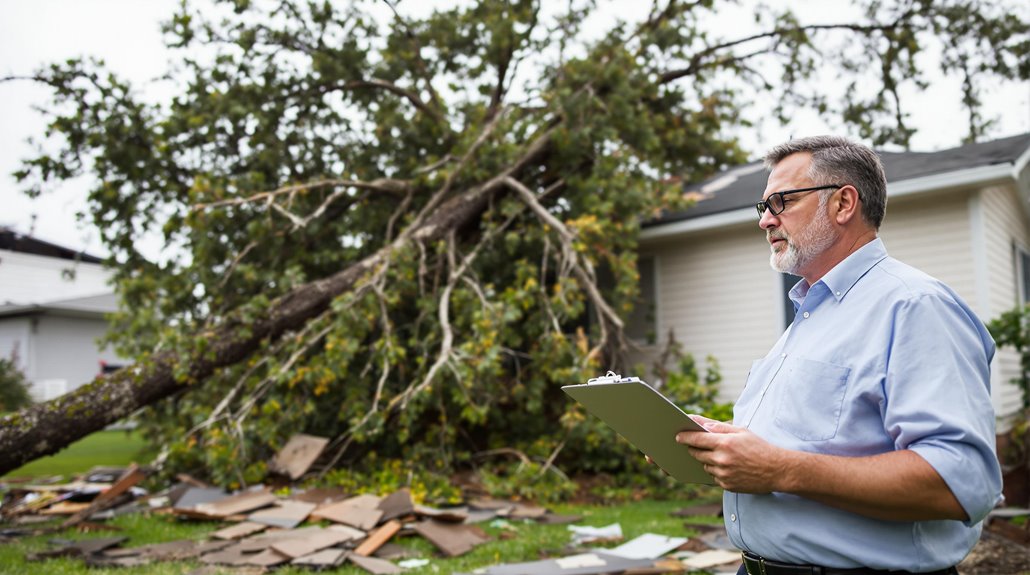
When property owners face wind damage claims, they should recognize that insurance company adjusters operate with a distinct agenda. These adjusters work primarily to protect their employer's financial interests, not the policyholder's needs.
Understanding adjuster ethics is essential, as their loyalty directly influences claim outcomes and potential claim denial scenarios.
Insurance company adjusters are tasked with:
- Minimizing payouts while maintaining compliance with policy terms
- Scrutinizing claims for exclusions or limitations that reduce liability
- Requiring extensive documentation to validate damage claims
Property owners should remain aware that these adjusters will thoroughly investigate claims to limit company exposure.
Their reports and assessments directly impact settlement amounts, often leading to reduced payouts or denied claims unless properly documented and supported.
This inherent conflict of interest can heavily affect the claims process and final settlement outcomes.
Getting Help From A Public Adjuster: Your Advocate & Ally
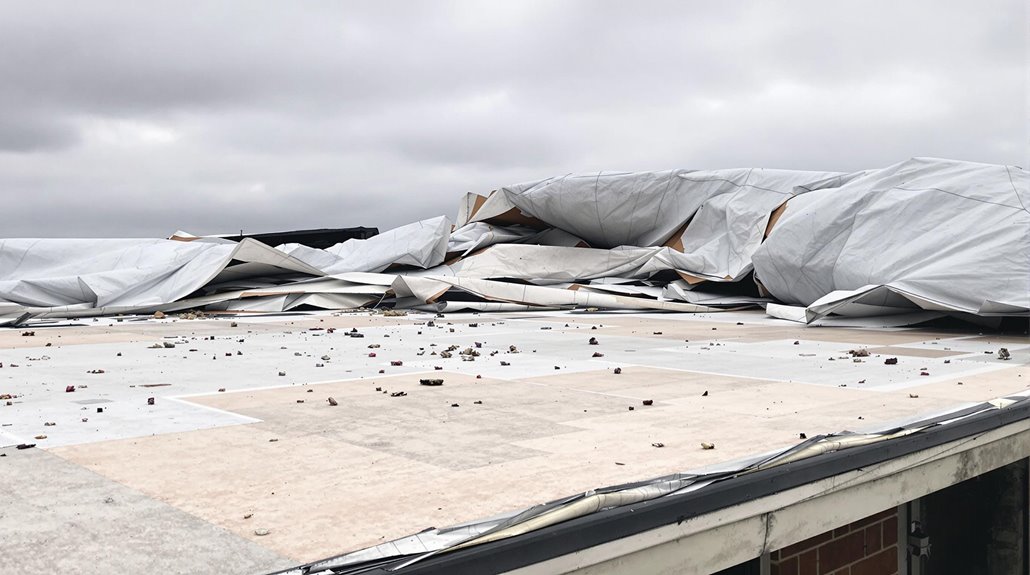
When dealing with wind damage to flat roofs, a public adjuster serves as an invaluable advocate who works exclusively for the policyholder's interests, unlike insurance company adjusters who represent the insurer.
Public adjusters typically charge a percentage of the final settlement amount, usually between 5-15%, and only get paid when the claim is successfully settled.
These licensed professionals bring specialized expertise in documenting wind damage, preparing thorough claims, and negotiating with insurance companies to maximize settlement amounts for flat roof repairs or replacements.
The Role Of Public Adjusters In Wind Damaged Flat Roof Claims
Professional guidance from a public adjuster can considerably impact the outcome of wind damage claims for flat roofs. These experts serve as dedicated advocates, leveraging their extensive understanding of insurance policies and claims processes to guarantee property owners receive fair settlements.
Public adjuster benefits extend beyond basic claims assistance. They conduct thorough damage assessments, gather vital documentation, and negotiate directly with insurance companies. Their expertise helps navigate complex claim requirements while identifying all covered damages.
They also maintain networks of reliable contractors and provide valuable risk management advice to prevent future issues.
When claims face denial, public adjusters facilitate disputes by providing detailed evidence, managing communication with insurers, and making certain all damage-related costs are properly documented and considered in the final settlement.
Benefits Of Using A Public Claims Adjuster For Wind Damaged Flat Roof Repair Or Replacement Claims
Securing the expertise of a public claims adjuster can greatly enhance the outcome of wind-damaged flat roof claims. Their specialized knowledge in claim negotiation strategies guarantees thorough damage assessments, proper documentation, and maximum policy coverage. Public adjuster benefits extend beyond paperwork management to include expert advocacy and efficient claim resolution.
| Benefit Category | Key Advantages | Impact on Claims |
|---|---|---|
| Expertise | Technical Knowledge | Enhanced Assessment |
| Time Management | Streamlined Process | Faster Resolution |
| Financial | Maximum Settlement | Better Compensation |
| Documentation | Complete Evidence | Stronger Case |
| Support | Professional Guidance | Reduced Stress |
How Are Public Insurance Adjusters Paid & What Are Their Fees?
Understanding public adjuster fees and payment structures is essential for property owners considering professional claim assistance. Most public adjusters operate on contingency fees ranging from 5-15% of the final settlement, with payment collected only after successful claim resolution. State regulations govern maximum allowable fees and payment methods to protect consumers.
| Fee Structure | Typical Range | Key Benefits |
|---|---|---|
| Contingency | 5-15% | No upfront cost |
| Hourly Rate | Varies by state | Predictable billing |
| Flat Fee | Set amount | Fixed total cost |
Compensation structures may vary based on claim complexity, property type, and disaster declarations. While hourly and flat-rate options exist, contingency arrangements remain most common, aligning the adjuster's interests with maximizing the policyholder's settlement. This incentive-based approach often results in higher claim payouts that can offset the adjuster's fees.
Public Adjusters Vs. The Insurance Company Adjuster
The fundamental distinction between public adjusters and insurance company adjusters lies in their roles, allegiances, and objectives during the claims process. While insurance company adjusters work to protect their employer's interests, public adjusters serve as dedicated advocates for policyholders, offering expertise and objectivity in claim settlements.
| Aspect | Public Adjuster | Insurance Company Adjuster |
|---|---|---|
| Representation | Works for policyholder | Works for insurance company |
| Objective | Maximum fair settlement | Cost containment |
| Expertise | Extensive policy knowledge | Limited to company policies |
| Payment | Percentage of settlement | Salary from insurer |
Public adjusters benefits include thorough damage documentation, expert negotiation skills, and reduced stress for property owners. In contrast, insurance adjusters limitations stem from their inherent company bias and focus on minimizing claim payouts while expediting closure.
When To Contact A Public Adjuster For Flat Roof Wind Damage
Professional guidance from a public adjuster becomes particularly valuable when property owners face flat roof wind damage. These experts specialize in flat roof inspections and can identify complex damage patterns that may be overlooked during routine assessments. Their expertise proves essential for wind damage mitigation and ensuring thorough documentation for insurance claims.
| Scenario | When to Contact | Expected Outcome |
|---|---|---|
| Visible Damage | Immediately after storm | Prompt damage assessment |
| Hidden Issues | During insurance disputes | Thorough investigation |
| Complex Claims | Before filing claim | Maximum compensation |
Public adjusters serve as advocates throughout the claims process, evaluating damage extent, interpreting policy coverage, and negotiating with insurance companies. They expedite the process by gathering necessary documentation, obtaining repair estimates, and ensuring all wind-related damages are properly addressed in the settlement.
When to Contact Your Insurance Provider For Flat Roof Wind Damage
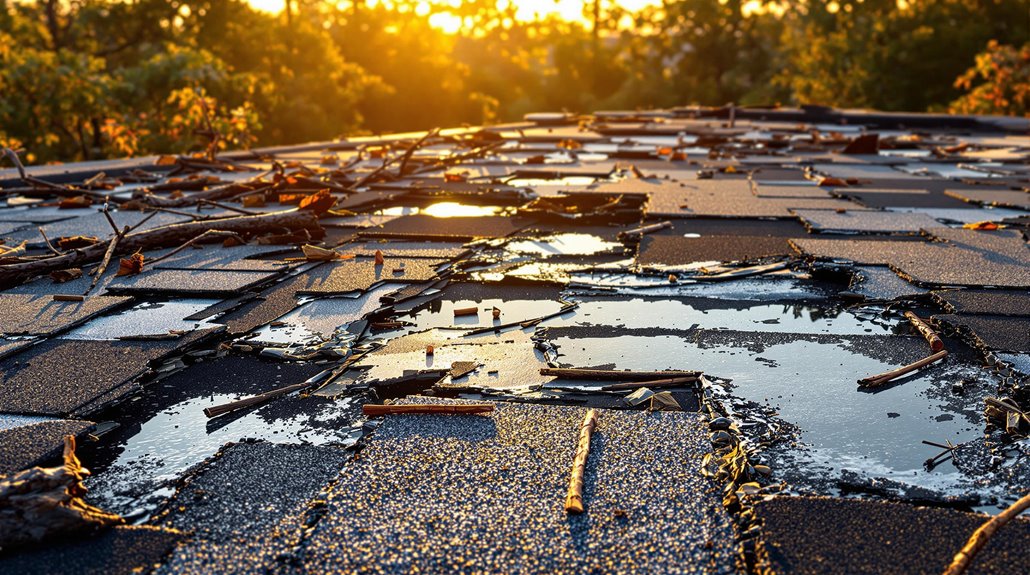
Property owners have two primary paths when initiating an insurance claim for flat roof wind damage: working directly with their insurance provider or enlisting a public adjuster's expertise.
Those filing independently should contact their insurer immediately after discovering damage, documenting all visible issues through photos and videos while reviewing their policy coverage details.
Public adjusters can manage the entire claims process on behalf of property owners, though their services typically require paying a percentage of the final settlement amount.
If Using A Public Adjuster
When homeowners discover wind damage to their flat roofs, engaging a public adjuster before contacting insurance providers can greatly improve claim outcomes.
Public adjuster roles encompass specialized expertise in adjusting insurance claims, particularly for complex wind damage situations involving flat roofs.
These professionals offer several key advantages: they conduct thorough damage assessments, manage all communications with insurance companies, and negotiate for maximum settlement values.
Operating on a contingency fee basis, public adjusters eliminate upfront costs while providing expert advocacy throughout the claims process.
They guarantee accurate documentation, maintain compliance with insurance requirements, and often expedite claim resolution through their established networks of contractors and industry knowledge.
Their involvement typically results in higher settlement amounts and reduced stress for property owners.
If Filing On Your Own
Homeowners who choose to file wind damage claims independently must approach the process systematically to maximize their chances of successful compensation. Effective filing strategies include thoroughly documenting all damage through photographs and videos, maintaining detailed records of correspondence, and understanding insurance policy coverage before initiating the claim.
To avoid common claim pitfalls, property owners should inspect and document damage immediately after the storm, noting the exact date of occurrence.
When interacting with insurance adjusters, homeowners should be present during inspections, providing context about the damage while ensuring all aspects are properly evaluated.
Keep records of any temporary repairs made to prevent further damage, as these costs may be reimbursable.
Review settlement offers carefully, comparing them against documented evidence and policy coverage.
Filing Process For Wind Damaged Flat Roof Claims Using A Public Adjuster
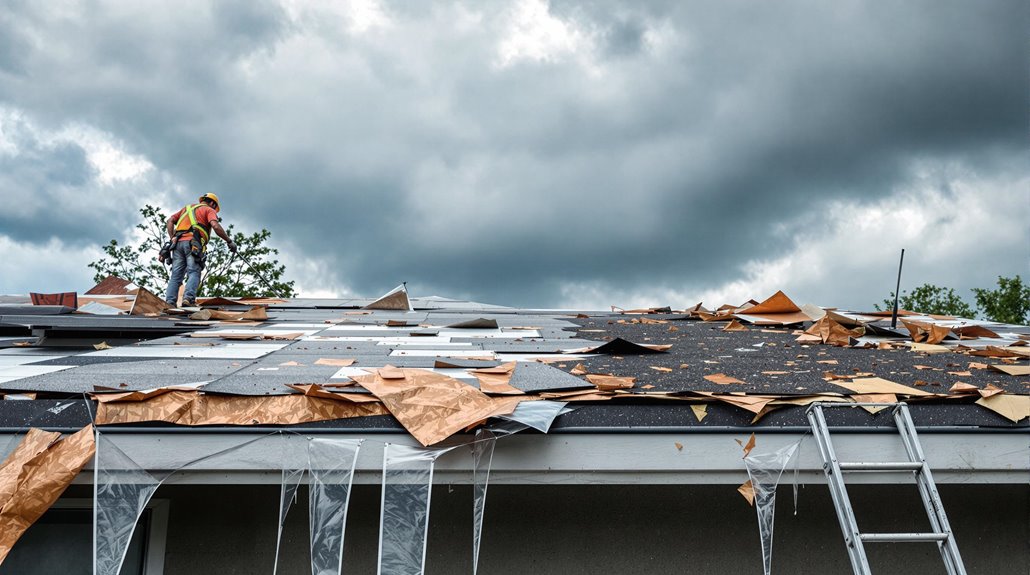
When dealing with flat roof wind damage claims, public adjusters serve as expert advocates who thoroughly inspect and document the full scope of damage while reviewing policies for maximum coverage benefits.
These professionals handle all communications with insurance companies, coordinate inspections, and manage the entire claims process on behalf of the policyholder.
Public adjusters strengthen claims by obtaining professional assessments and gathering extensive evidence to support the documented damage.
- Detailed documentation includes high-resolution photographs, videos, weather data, and structural analysis reports to establish the extent of wind damage.
- Professional estimates from qualified roofing contractors help validate repair costs and necessary scope of work.
- Expert policy analysis identifies all applicable coverage provisions, ensuring no legitimate benefits are overlooked during the claims process.
Public Adjuster Thoroughly Inspects & Documents Wind Damage To Your Flat Roof
Securing a thorough wind damage claim for a flat roof requires meticulous documentation and expert assessment from a qualified public adjuster. During the property assessment, the adjuster employs specialized tools like moisture meters and drones to detect both visible and concealed damage. The damage documentation process includes extensive photographs, videos, and detailed written descriptions to support insurance claims.
| Inspection Area | Assessment Tools | Documentation Required |
|---|---|---|
| Roof Membrane | Moisture Meters | Photos & Videos |
| Flashing & Edges | Drones | Written Reports |
| Interior Ceiling | Thermal Scanners | Damage Measurements |
| Insulation Layer | Visual Inspection | Repair Estimates |
| Support Structure | Safety Equipment | Historical Records |
The public adjuster makes sure all aspects of wind damage are properly recorded, from displaced insulation to membrane tears, creating a solid foundation for successful claim negotiations with insurance companies.
Public Adjuster Reviews Policy For Hidden Roofing Coverage & Helps Maximize Policy Benefits
Following the thorough inspection and documentation phase, a skilled public adjuster begins an in-depth analysis of the insurance policy to uncover hidden roofing coverage and maximize potential benefits for wind damage claims. Through expert insurance advocacy, adjusters identify overlooked provisions and guarantee extensive coverage for all wind-related damages.
| Policy Review Elements | Benefits | Action Steps |
|---|---|---|
| Coverage Limits | Hidden Benefits | Policy Analysis |
| Building Codes | Extended Coverage | Code Review |
| Additional Riders | Enhanced Payout | Documentation |
Public adjusters employ specialized software and industry knowledge to optimize claim values while guaranteeing compliance with local building regulations. Their expertise in policy interpretation often reveals additional coverage options that property owners might otherwise miss, such as provisions for code upgrades or secondary damage remediation.
Public Adjuster Contacts Insurance & Deals With Insurance Company Adjusters On Policyholders Behalf
Public adjusters initiate the claims process by contacting the insurance company and establishing themselves as the policyholder's designated representative. They manage all communications and negotiations with insurance adjusters, ensuring complete documentation of wind damage through detailed reports and photographic evidence.
This professional representation offers significant public adjuster benefits, as they skillfully navigate complex insurance negotiations while advocating for maximum claim compensation.
- Handles all paperwork submissions and claim documentation requirements, reducing stress for property owners.
- Conducts thorough damage assessments and provides detailed reports to support insurance negotiations.
- Maintains consistent communication with insurance adjusters to address questions and facilitate additional inspections when needed.
The public adjuster's expertise helps streamline the claims process while working to secure fair settlements based on documented damage and policy coverage.
Public Adjuster Gets Professional Assessments
When filing wind damage claims for flat roofs, professional assessments serve as the foundation for successful settlements. Public adjusters strategically coordinate with qualified professionals to conduct thorough evaluations, ensuring assessment accuracy and extensive documentation.
These detailed inspections analyze structural integrity, identify covered perils, and provide precise repair estimates essential for strategic negotiations with insurance companies.
- Professional assessors generate detailed reports documenting all wind-related damages, from displaced membranes to compromised flashings.
- Expert analysis includes photographic evidence, measurement data, and itemized cost breakdowns for materials and labor.
- Assessment findings support the public adjuster's claim strategy by establishing clear connections between wind events and documented damages.
This systematic approach to professional assessments strengthens the policyholder's position during the claims process, often leading to more favorable settlement outcomes.
Public Adjuster Gathers Supporting Evidence
Gathering extensive evidence forms the cornerstone of successful wind damage claims for flat roofs. A public adjuster systematically documents all damage through detailed visual records and precise written documentation. This evidence organization process guarantees proper claim substantiation when dealing with insurance companies.
| Documentation Type | Required Elements | Purpose |
|---|---|---|
| Visual Records | Photos, Videos, Aerial Views | Capture Damage Extent |
| Written Records | Item Lists, Values, Receipts | Track Losses |
| Expense Tracking | Repair Costs, Living Expenses | Document Financial Impact |
| Communication Log | Adjuster Notes, Company Responses | Maintain Case History |
The adjuster maintains an organized system of evidence that includes dated photographs, detailed damage descriptions, repair estimates, and related expenses. This systematic approach strengthens the claim's validity and facilitates smoother interactions with insurance providers during the settlement process.
Public Adjuster Submits Complete Claims Package
A thorough claims package submission represents the culmination of a public adjuster's investigative and documentation efforts for wind-damaged flat roofs. The adjuster organizes extensive documentation to support the claim, maximizing the potential for a successful settlement.
| Claims Submission Components | Public Adjuster Benefits |
|---|---|
| Detailed Damage Assessment | Expert Documentation |
| Professional Inspection Reports | Thorough Evidence Collection |
| Photographic Evidence | Strategic Claim Presentation |
| Cost Estimates & Invoices | Maximum Settlement Potential |
| Engineering Reports (if needed) | Professional Negotiation |
The public adjuster guarantees all required documentation meets insurance company standards before submission. This includes property maintenance records, repair estimates, temporary repair receipts, and professional inspection findings. Their expertise in claims submission tips helps streamline the process while avoiding common pitfalls that could delay approval or reduce settlement amounts.
Public Adjuster Handles All Follow Up & Time Requirements With Insurance Company
Once a claim is submitted, public adjusters take full responsibility for managing all subsequent interactions and time-sensitive requirements with insurance companies. Among the key public adjuster benefits is their expertise in maintaining strict adherence to claim timelines while coordinating all necessary appointments, documentation, and communications with insurers.
These professionals systematically manage the entire follow-up process, ensuring no deadlines are missed and all policy requirements are met. They handle extension requests when needed and keep policyholders informed of claim progression.
- Negotiate directly with insurance adjusters to expedite claim resolution
- Monitor and respond to all insurance company requests within required timeframes
- Coordinate additional inspections and documentation if initial claims are challenged
Public adjusters effectively navigate complex insurance procedures while maintaining detailed records of all interactions and submissions, maximizing the likelihood of favorable claim outcomes.
Public Adjuster Enforces Policyholder's Rights, & Negotiates Higher & More Fair Settlement
Professional public adjusters maximize policyholder settlements by enforcing contractual rights and negotiating aggressively with insurance companies during wind damage claims. Through expert negotiation strategies and detailed documentation, they guarantee claims are properly valued and all damages are accounted for.
Public adjuster benefits include extensive damage assessments that identify both obvious and hidden issues, leading to more accurate settlement amounts.
- Thorough policy analysis to leverage all available coverage options and benefits
- Strategic documentation of wind damage patterns to counter potential claim denials
- Expert valuation of repair costs to prevent insurance company underestimation
These professionals understand complex policy language and insurance regulations, enabling them to effectively challenge unfair settlement offers.
Their expertise in claim negotiation often results in considerably higher compensation compared to settlements obtained without professional representation.
Public Adjuster Speeds Up Claim Settlement Time
Filing wind damage claims becomes considerably more efficient when property owners engage public adjusters, reducing settlement timelines by weeks or even months. These professionals streamline the claims process through systematic documentation, expert communication with insurers, and thorough understanding of policy requirements.
Their established protocols for damage assessment and evidence collection expedite claim approvals.
- Public adjusters manage all insurer communications, eliminating delays caused by miscommunication or missing information.
- They prepare detailed damage documentation upfront, preventing multiple rounds of information requests.
- Their expertise in policy interpretation helps avoid common pitfalls that typically slow down settlements.
Public adjuster benefits extend beyond faster claim settlement times, as they simultaneously work to secure ideal compensation while accelerating the overall process through professional management of all claim aspects.
Choosing & Working With Trusted Flat Roof Contractors
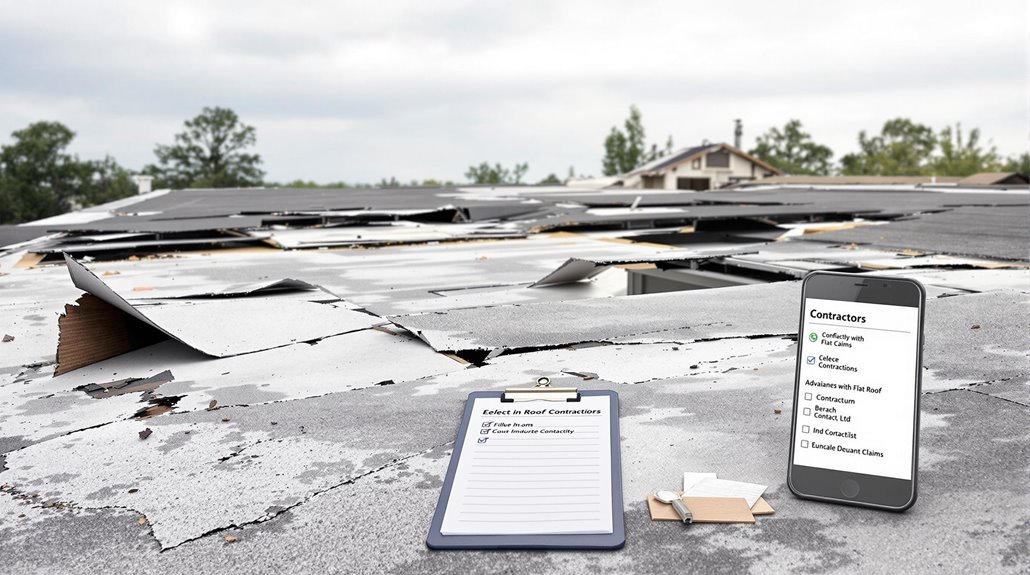
Public adjusters maintain extensive networks of qualified flat roof contractors who can provide accurate damage assessments and repair estimates. Their established relationships help property owners avoid unreliable or unethical contractors while ensuring competitive pricing and quality workmanship. Professional adjusters analyze contractor estimates to verify appropriate scope, fair pricing, and thorough coverage of wind-related damages.
| Contractor Selection Criteria | Adjuster's Role |
|---|---|
| License & Insurance Status | Verification of credentials and coverage limits |
| Project Experience & History | Analysis of past wind damage repair projects |
| Material & Labor Estimates | Review of pricing accuracy and scope completeness |
Utilize Your Public Adjusters Extensive Professional Network
Leveraging a public adjuster's extensive professional network provides homeowners with access to trusted flat roof contractors who specialize in wind damage repairs. These established contractor partnerships guarantee quality workmanship while streamlining the claims process for property owners.
Public adjuster benefits extend beyond claims advocacy, as they can connect homeowners with vetted contractors who have proven track records in wind damage restoration.
These professionals typically work on a contingency basis, aligning their interests with successful project completion. Their contractor network consists of licensed, insured professionals who understand insurance company requirements and local building codes.
Additionally, public adjusters help identify hidden structural damage that might otherwise go unnoticed, facilitating thorough repairs through their trusted contractor relationships.
This collaborative approach maximizes claim settlements while maintaining high repair standards.
Getting Professional Flat Roofing Repair Or Replacement Estimates
Selecting a qualified flat roof contractor represents the foundation of successful repair or replacement projects. Professional contractors should demonstrate extensive experience, proper licensing, and thorough insurance coverage. During the flat roof assessment, contractors evaluate damage extent and provide detailed estimates for both repair and replacement options.
| Contractor Requirements | Documentation Needed | Key Considerations |
|---|---|---|
| Valid License | Insurance Certificates | Experience Level |
| NRCA Certification | Detailed Estimates | Project Timeline |
| Liability Coverage | Warranty Documents | Material Options |
| Client References | Building Permits | Code Compliance |
| Written Guarantees | Project Contracts | Payment Terms |
When evaluating contractor qualifications, prioritize those offering transparent communication, detailed cost breakdowns, and assistance with insurance claims. Verify their adherence to local building codes and ability to provide thorough warranties for both workmanship and materials.
Let Your Public Adjuster Review Estimates To Ensure Contractor Honesty
Once homeowners obtain contractor estimates for flat roof repairs or replacements, having a qualified public adjuster review the documentation serves as a critical safeguard against potential overcharging or underbidding.
Public adjusters evaluate estimates using professional standards and software like Xactimate to guarantee estimate transparency and contractor accountability.
These independent professionals work closely with experienced contractors to verify that all necessary repairs are included while maintaining compliance with local building codes.
Their expertise helps identify discrepancies between contractor estimates and insurance claims, guaranteeing extensive coverage of wind damage repairs.
Through this collaborative approach, public adjusters protect homeowners' interests by confirming that estimates are both honest and thorough, ultimately facilitating fair insurance settlements and proper repair execution.
Preventing Future Flat Roof Damage From Wind
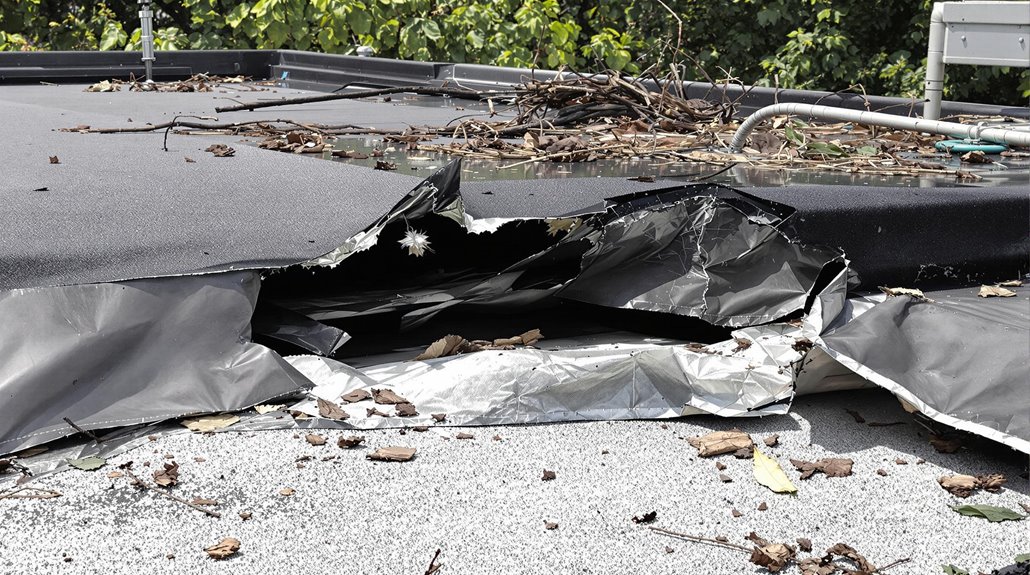
While flat roofs offer numerous advantages for commercial buildings, they require specific preventative measures to withstand wind damage effectively. Implementing thorough flat roof maintenance and wind resistance strategies greatly reduces vulnerability to severe weather conditions.
| Preventative Measure | Implementation Strategy |
|---|---|
| Regular Inspections | Quarterly professional assessments |
| Material Selection | Install wind-rated PVC or EPDM membranes |
| Structural Support | Reinforce edges and corners |
| Drainage Systems | Maintain clear, functional drains |
| Professional Installation | Use certified local contractors |
Critical elements include using wind-resistant materials like Duro-Last commercial roofing systems and reinforced membranes. Property owners should focus on maintaining proper fastening systems, ensuring adequate drainage, and promptly addressing any signs of damage. Regular trimming of nearby trees prevents debris accumulation and potential impact damage during high winds.
About The Public Claims Adjusters Network (PCAN)
The Public Claims Adjusters Network (PCAN) serves as a critical professional association that connects licensed public adjusters across the United States. This organization provides Public Adjuster Resources to help members navigate complex insurance claims and maintain regulatory compliance across jurisdictions.
PCAN Membership Benefits include access to extensive policy analysis tools, documentation standards, and negotiation strategies that enhance adjusters' ability to serve their clients effectively. Members receive updates on state-specific legal requirements, fee structures, and contractual obligations.
The network facilitates knowledge sharing about coverage interpretations, claim documentation procedures, and effective communication with insurers and policyholders. Through PCAN, public adjusters can strengthen their expertise in evaluating wind damage claims, understanding policy limitations, and securing fair settlements for their clients.
References
- https://www.kirberg.com/flat-roof-wind-damage/
- https://northfaceconstruction.com/blog/wind-damage-to-roof/
- https://vtroofing.com/tips/roof-wind-damage-comprehensive-guide/
- https://www.billraganroofing.com/blog/how-spot-wind-damage-roof
- https://premiersystemsroofing.com/blog/how-are-commercial-flat-roofs-susceptible-to-wind-damage/
- https://bmroofing.com/wind-damage-to-roof/
- https://www.homeevolution.net/blog/recognizing-wind-damage-on-your-roof-a-comprehensive-guide/
- https://www.superstormrestoration.com/blog/how-to-tell-if-high-winds-damaged-your-roof/
- https://www.billraganroofing.com/blog/insurance-cover-roof-damage-wind
- https://www.qeiroof.com/wind-damage-roof-insurance-claims/
